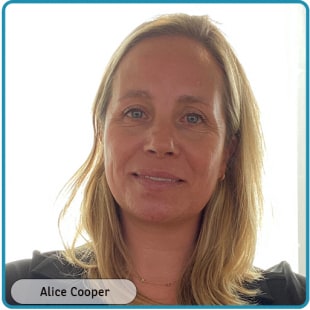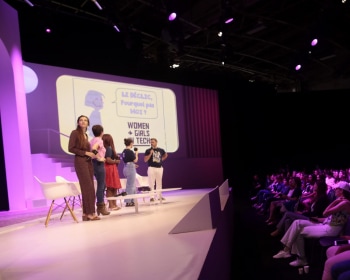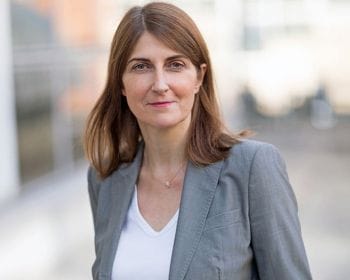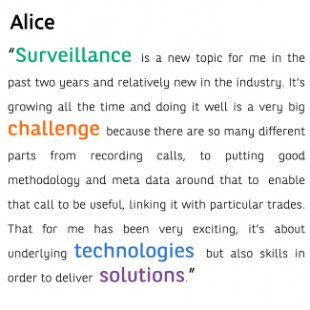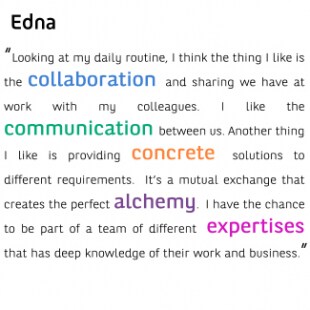Did you imagine you would enter into a man’s world when you chose IT?
Alice Cooper (A.C.): When I went to University, there were 180 people on the course and … just four women! That was an eye-opener and that really surprised me. I always enjoyed mathematics and science. I could not wait for these classes when I was young. I went to an all girls’ school and those subjects were well attended. That was a surprise... But it did not stop me! When I started at BNP Paribas, I truly did not notice the lack of women. It’s only since I have taken this new role on CIB ITO Women in IT lead over the last years that I’ve really seen the statistics. We have to work to change the view of children today to show a career in STEM is a fantastic opportunity. We are working hard on that, and I'm super motivated by it. We are lacking women and we this must change.
Edna Costagliola Di Fiore (E.CDF.): It is a fact that there is a minority of women, but I hadn’t realised that this is a sector with a lack of women. Honestly, as I grew up with a part of my family working in IT, I never felt I was part of a minority.
What did you first love about IT?
A.C.: On my course, I did programming, workflows, business scenarios, and to some extent it prepared me for the world of work. My first office challenge was to automate a manual process. That was the first time I was using a database; I was running the manual process myself every day and it took two or three hours. Within the first two or three months I had built up a database and a solution where one could press a button and run the process in just five minutes. It was not a hugely technical challenge but very satisfying. That’s where I started.
E.CDF: When I started to code, I appreciated the fact that there are a lot of activities where you can be creative. In the engineering, you have physics, mathematics, but you also have coding: it is not a binary sector. You can evolve, trying things as you go. And these studies prepare you for the real world. There is a concrete application of your studies.
A.C.: I agree! I relate to Edna’s passion. People don’t realise how lucky we are to be in the engineering world. We work with bright people, are challenged day in day out, we find solutions ourselves, and we collaborate with other people. And people think “I'm creative, I’m artistic, it’s not IT”. But it is IT! Whatever your passion, when you’re learning, you have opportunities in the IT world because it is so wide-ranging.
"This is a warm and pleasant sector where people are so inclusive, I never felt part of a minority."
How could you define IT?
A.C.: IT is, first and foremost, systems and servers. A lot of what I have delivered from day 1 is a combination of functional and technical solutions, i.e., automated solutions for clients. In my experience at BNP Paribas, all departments come to IT with their requirements, and we look to automate solutions so they are able to do more, work faster, and process quicker than our competitors. For me this is what IT is all about.
E.CDF: I would say that the first mission of IT is to provide our clients with concrete solutions. We are advisors for business. They have a mission and the ambition, and we have to understand the mission statement and provide a concrete solution. It could be an application, it could be a cloud solution, a security solution, there are a lot of possibilities. IT is more or less the engineering world but in IT you also have different, additional, roles: you can be the engineer, you can be the project manager, the advisor, the auditor…
A.C.: You can also be the architect, the test analyst, the business analyst… !
What are your day-to-day tasks?
What are your business relationships with other departments in BNP Paribas?
A.C.: Our job is to automate their solutions, to enable them to do greater volumes, to help them to invest in more complex challenges, and I like to think that we also help them to simplify complex tasks. In summary, I think we also centralize collaboration. The world is big, and IT can make it small. It’s a collaboration whether it’s business, trading, finance, payments, operations, and that’s part of why we do have mobility. I have a new programme manager who moved from finance this year and she’s doing a terrific job. It’s a learning curve for her, particularly the systems and the Global Market IT best practices. GM IT benefits too as she brings a wealth of experience and methods from a different domain. I had many graduates joining my previous teams and now some of them are running teams all around the world. They've got incredible careers having built strong foundations by learning and understanding IT!
E.CDF: IT is at the crossroads of all the business departments. On the front we have the business,our clients, on the back you have the engineers. Every day we work with different IT departments: the Production, the Risks, the Compliance, the Finance but also with teams based in other countries/regions… and in each region you have the same: the IT, the business, the production. It’s a melting pot of everything, different cultures, organizations, and we must work together because our solutions are everywhere.
What are the peculiarities of the IT department at BNP Paribas?
A.C.: IT within BNP Paribas is future oriented. It’s not standing still. We’ve always got a plan for the next three or five years whether that is related to a business requirement or a technical challenge. BNP Paribas IT Teams could compete with any software company in the market: we have top employees and resources, applications, huge investments, we are very competitive with any vendor.
E.CDF: I don’t know of another bank that has such a huge IT department. We are 40,000 people in 50 countries. All the IT in the countries have the same commitment to provide IT standards and technologies for the hard business. We are looking further, I do agree with Alice, with managers who lead us to embrace new technologies.
Alice & Edna in a few words
Alice Cooper is Global Head of Global Markets IT Regulatory, Surveillance and Conduct, based in London. “I manage a combination of people and applications. The people are developers, business and test analysts, architects, project and programme managers, technical leads and team leads. Many of the roles are blended.”
I was born and raised for my early years in London before my family moved to the countryside, to a farm. I took a degree in Computer Science and Applied Statistics at Oxford Brookes University. Other than playing Tetris and Pacman when I was young I really did not have IT experience before starting my degree.
I was born in Italy, but I did all my education in a French school and then I studied for a diploma in Engineering in IT and Management from an Italian University, after a year’s exchange program at the Polytechnic school of Barcelona. I discovered IT both via my studies and through my family as my brother and mother both worked in this field. They inspired me to study the sciences and IT.
Photos : ©Inti St. Clair, HQUALITY, NDABCREATIVITY, fizkes, BNP Paribas


